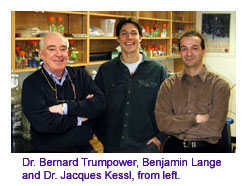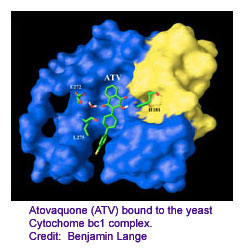
|
For Release: January 20, 2004
Contact: DMS Communications (603) 650-1492
Print Version
Yeast Model to Combat Antibiotic-Resistant Pneumonia and Malaria
Hanover, NH - New biochemical studies may hold clues to more powerful malaria and pneumonia treatments that could save more than 2 million lives worldwide.
Using baker's yeast as a surrogate disease model, researchers led by Dartmouth Medical School are exploring why enzymes in organisms that cause pneumonia and malaria are becoming increasingly resistant to antibiotics. This work could provide the answer to testing a new generation of drugs to combat these widespread diseases. Malaria and pneumonia are responsible for more than 2 million deaths worldwide a year, said Dr. Bernard Trumpower, a professor of biochemistry at DMS who headed the study.

Investigators used genetically modified yeast enzymes to pinpoint the mutations responsible for the antibiotic resistance of Pneumocystis jirovecii, which causes a type of pneumonia that is the most serious and prevalent AIDS-associated opportunistic infection and a threat to other immunocompromised patients, such as those undergoing therapy for cancer and organ transplantation.
Appearing in the January 23 Journal of Biological Chemistry, the study examines the mutations responsible for disease�s tolerance toward atovaquone (ATV), a drug prescribed since 1995 that inhibits a respiratory enzyme called the cytochrome bc1 complex, that is essential for the pathogen�s survival. The lead author, Dr. Jacques Kessl, a research associate in biochemistry, said the study addresses recent evidence that indicates that pathogens that cause malaria and pneumonia are increasing resistance to ATV by developing mutations that prevent the drug from acting on the bc1 complex.
"We were able to isolate the genetic mutations that enable the pathogens to resist the drug when it is introduced to our yeast samples," said Dr. Bernard Trumpower, professor of biochemistry at DMS and corresponding author of the study. "As the genetically modified yeast strains now display atovaquone resistance identical to that found in pneumocystis, these yeast can be used to design new drugs to make the appearance of resistance more unlikely."

The study builds on prior research in Trumpower's lab that used yeast enzymes as accurate and easily modified models to explore the resistance to ATV. It is not possible to grow pneumocystis enzymes in the large quantities necessary to isolate and study the cytochrome bc1 complex. Yeast is an excellent resource that can be manufactured in large quantities and can be easily modified to take on the qualities of more dangerous pathogens.
The researchers were able to genetically transfer into the yeast cytochrome b mutations like those found in the atovaquone resistant pneumocystis and found that these mutations caused the yeast to acquire similar resistance to ATV.
The team used a computer program to construct molecular models of the enzymes. "We can now visualize the different mutations in three dimensions to predict how the enzyme will react to different changes, like the introduction of a new antibiotic," said co-author Benjamin Lange, a research assistant at DMS.

"We are infinitely further along than we were three years ago in terms of understanding the basis for resistance in these organisms," said Trumpower. The co-authors of the study are Dr. Steven Meshnick from the University of North Carolina and Dr. Brigitte Meunier from the Wolfson Institute for Biomedical Research in London. The study was funded in part by the NIH.